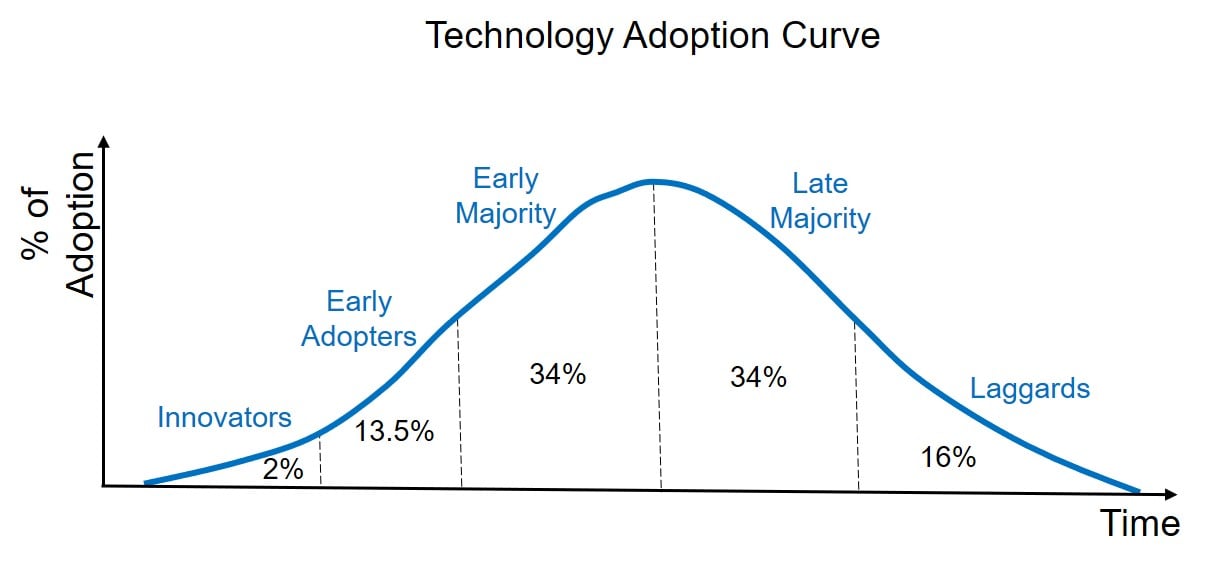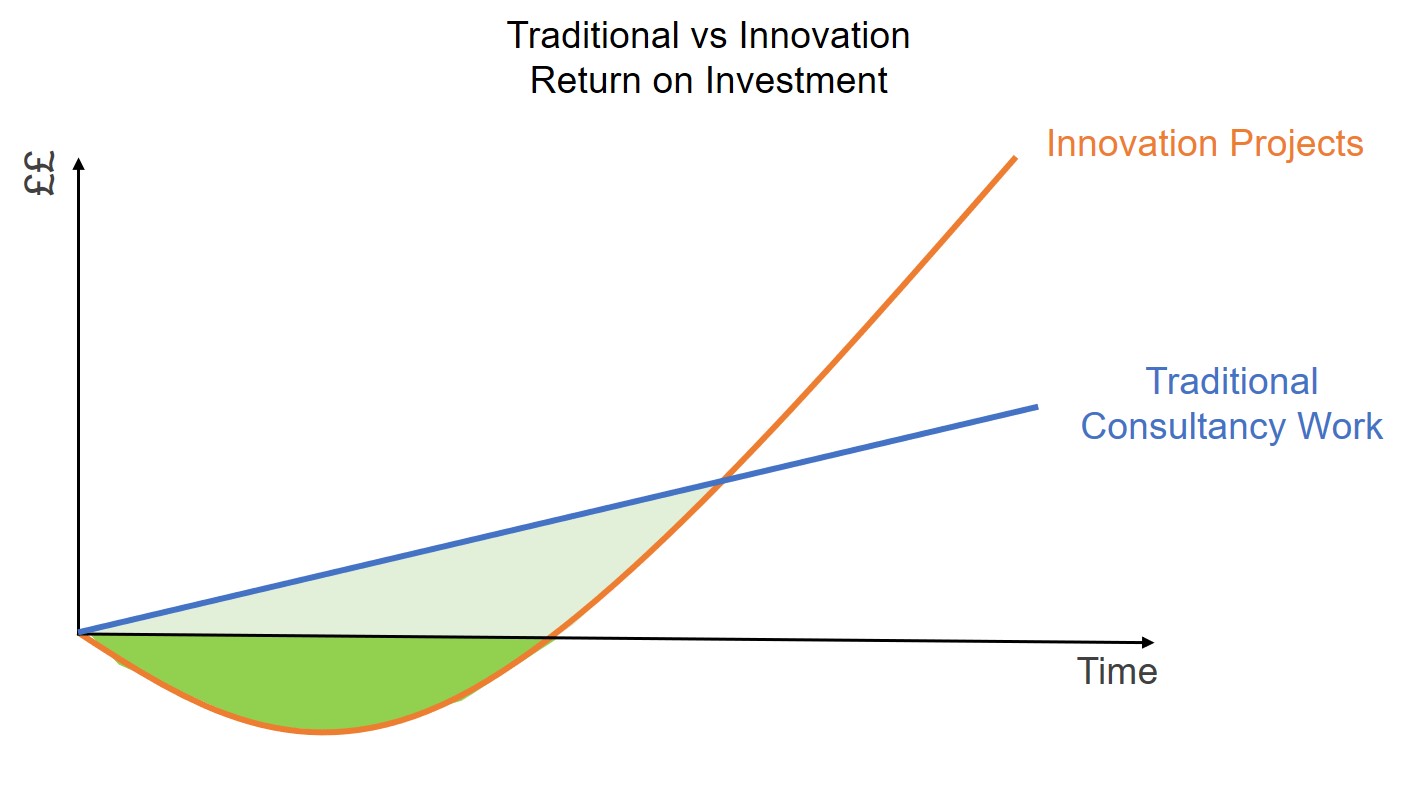How to fast track the adoption of innovation and technology in the AEC industry.
Lots of great new technological advances and innovations are coming into the Architecture, Engineering and Construction (AEC) industry. These range from individuals creating apps on projects to new technologies or systems that are spreading through the industry. But one of the key questions we should be asking is how often are these investments made in developing new technology for it only to be used once or twice and never to be widely adopted?
The adoption of a new technology follows a curve, starting with the innovators and early adopters through to the late majority and laggards. Some technology has successfully navigated this curve, such as BIM, while others are still starting on their journey to widespread adoption – robotics, digital twins for example. However, there have been many technologies that have started on the curve but never made it into the hands of the early majority or even being suggested as an idea.

There are many challenges and reasons as to why innovations are not being adopted, which span all levels of the industry. The reasons for non-adoption range from industry culture and industry red tape, to the short-term business drivers of AEC companies themselves as well as the skills of the individuals within an organisation. However, there is also a great appetite to make change and innovation happen. New ideas and ways of working, delivered by talented, highly driven people in exciting start-up companies or in pockets of traditional businesses, who are looking to disrupt the industry, are starting to appear. But are AEC companies really open to this change? Do current company environments foster new ideas, and nurture new talent and new approaches? We need to ensure that we are creating an environment which is conducive to supporting emerging technology and innovation whether from existing companies in the industry or new SMEs entering the market. Below are three, of many, considerations that we believe can help to achieve this.
A SHIFT IN MINDSET
One of the biggest challenges the AEC industry faces when it comes to developing new technology and innovation is mindset. There are many stories of companies who have invested thousands of product development hours as well money to bring a new innovation to market, only for it to be rejected by clients saying “that looks great, but it doesn’t actually solve a problem we have” or “I wouldn’t actually pay for this”. This is the risk of having a mindset where you only engage with potential clients when a new product or service is complete.
Even if you have been in the industry for some time, you will be developing an idea based on your own experiences and perspectives rather from that of an actual client. This approach may allow you to fast-track your project from the start but innovators need to ensure they are asking the right client questions to ensure they are creating a solution that multiple clients will really want and will actually pay for. This should not be a one-time endeavour, but client feedback should be a key facet of throughout the inception and development process in order to ensure you are continuing to build a solution the market wants. This can feel counter-intuitive as approaching clients with ideas or unfinished products is not a traditional approach, but co-creation offers AEC companies a great opportunity to strengthen your client relationships and give you far more understanding of what their challenge really are.
|
“In times of great change, experience can be your worst enemy.” John Paul Getty. |
INNOVATION TAKES INVESTMENT
From testing new technology on a project to creating a whole new software platform or service for the industry; an investment of time, resource or money will be required at the start. Whether it’s the time to learn or research the new method or the actual development costs of creating a tool or asset; there will be an initial sunk cost which may result in that specific project not being as profitable or the business taking a loss in the short-term. The goal here, however, is the longer-term gains, when an innovation is more developed or more integrated into a workflow then the benefits of speed and value become far clearer. This product development model is a stark contrast to the traditional consultancy delivery approach that the AEC industry tends to adopt, where over time the amount of work is proportionate to the fee or value you get in return. With this approach the risk is much lower but it also will produce the same result with no innovation, or very little at a much slower pace. For innovation to occur this must be acknowledged at the start and project managers must account for these sunk costs as part of their project planning process. Companies will need to develop business goals which balance profit making with encouraging innovation. Clients will also play an instrumental role in realising the value of innovation in the project delivery process.

FASTER SHOULD NOT EQUAL CHEAPER
Using technology and innovation often results in tasks or jobs being done faster. But this does not mean that the industry should just be making their work cheaper as it will simply result in a race to the bottom where everyone is priced out. This will not produce the best project outcomes for those who will be using the places that the AEC is trying to create. With innovation on the rise, the traditional time and material-based market approach begins to fall apart and a new understanding of the value these technologies add needs to be captured and priced for.
On the other side clients and the industry must become more outcome, rather than output, based. This enables value to be quantified and considered in a much more collaborative way which will lead to better solutions for communities and the environment. New value-based contracts and procurement systems that promote and foster innovation and change in the industry should be the norm. This will be a big shift for the industry; however the concept is not as farfetched as people think. We are more used to these value-based pricing approaches in our day-to-day lives – for example paying a value premium for an Apple branded product compared to a standard computer or paying more to ensure a packages is delivered faster.
In conclusion, technology and innovation in the AEC industry is definitely happening with the advancement of digitising/digitalision. However, for these new approaches to succeed the industry must adapt and improve in order to create an environment which is much more open to promoting and encouraging innovation. A lot of this change should stem from changing mindsets at all levels of the industry and will require a coordinated approach with the industry, clients, and suppliers to truly embed new technologies and innovations. If we can achieve this, we can drive a more efficient, productive industry that creates better outcomes for all.
